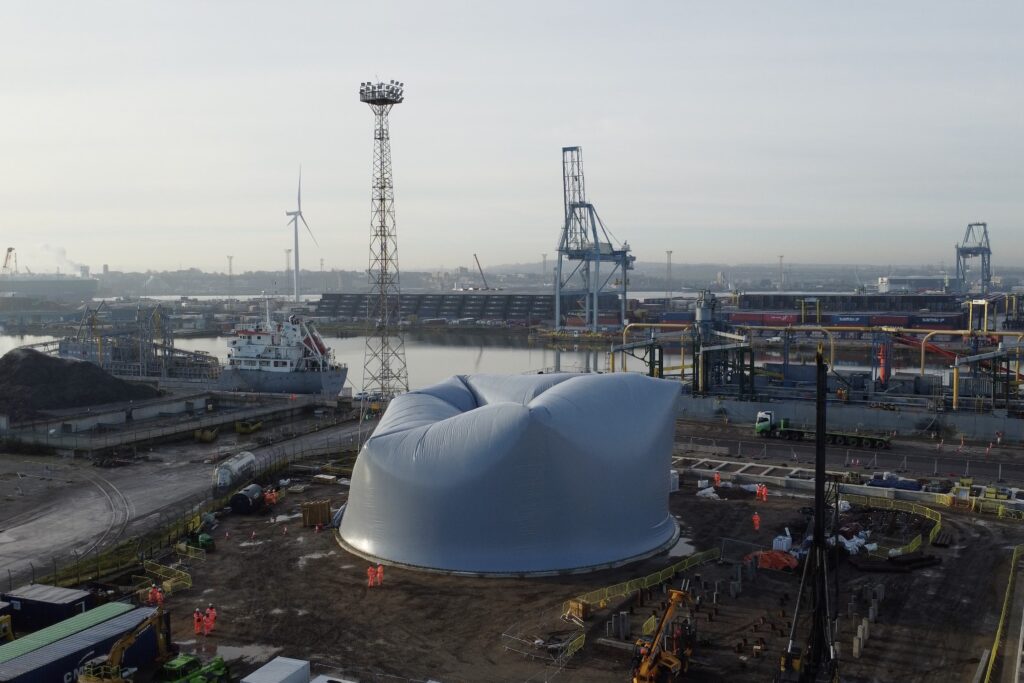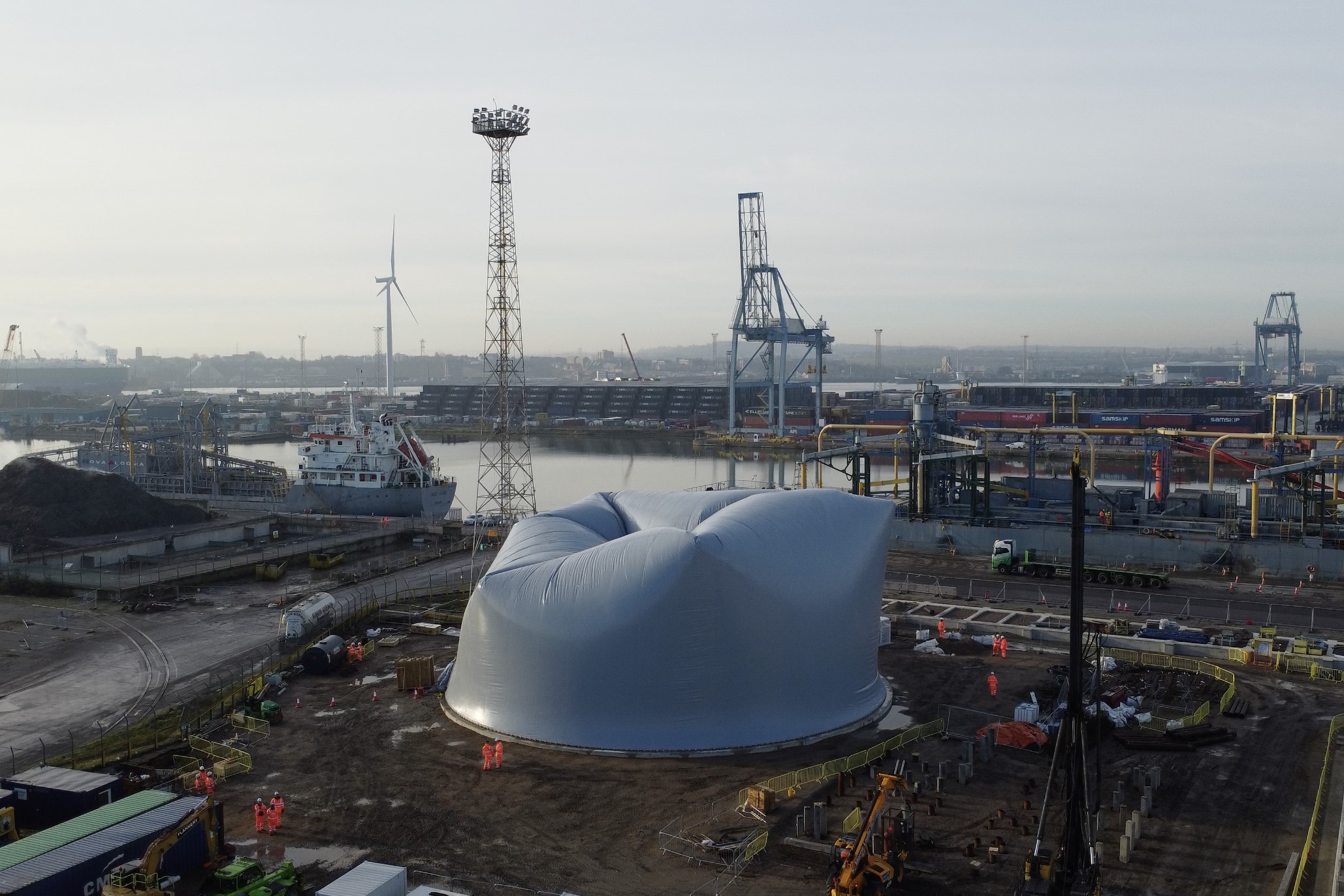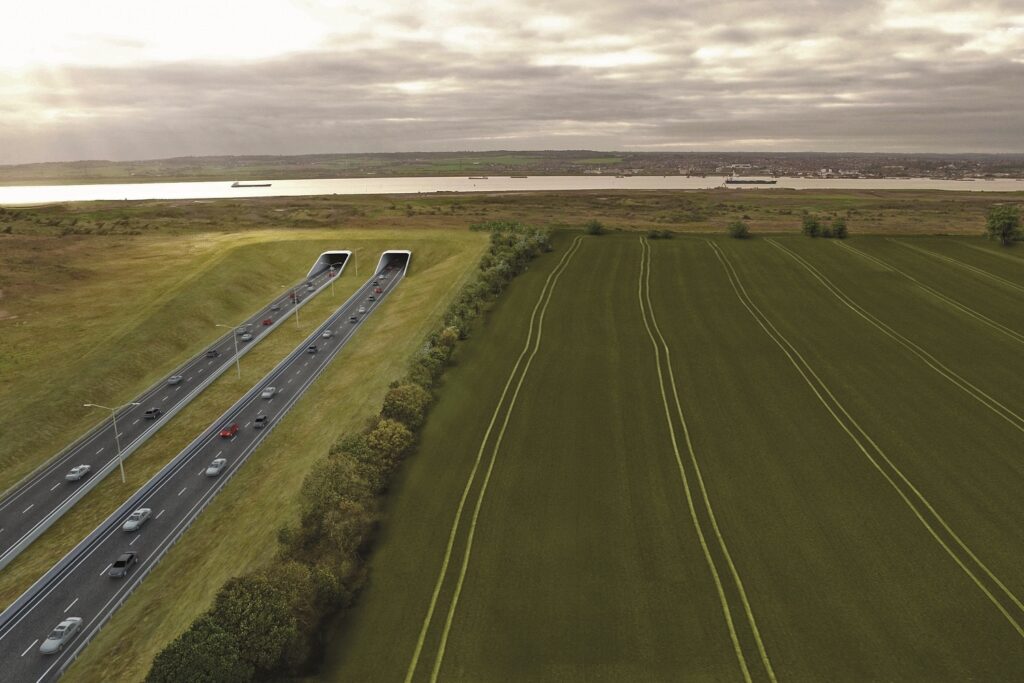How Aggregate Industries’ upgrades at Tilbury Docks will benefit major infrastructure projects

This post was originally published on this site
Materials supplier Aggregate Industries has created an innovative dome silo at Tilbury Docks as just one of its upgrades to facilitate better supply of cement to major infrastructure projects like Sizewell C and Lower Thames Crossing.
Tilbury Docks, also called Port of Tilbury, is an industrial area on the north side of the River Thames in Essex to the east of London.
The upgrades include a large silo which was built using an inflatable dome, which is then in-filled with concrete, with the purpose of storing cement.
The silo is intended to improve resilience for UK projects and supply chains because of how much storage capacity it adds to Aggregate Industries offering.

The dome silo being inflated
In addition to the silo, five weigh bridges will allow faster shipment of cement.
Earlier this month, Aggregate Industries explained that “Dome Technology inflated the airform and will now commence placing nearly 4,500m3 of sprayed and wet mix concrete to form the 45m tall, 32m diameter dome silo, which will eventually store 30,000t of cement.”
Aggregate Industries project manager Tim Fry said: “This new facility is a strategic investment in both the infrastructure of Tilbury and in Aggregate Industries’ mission to lead in supplying low-carbon, sustainable construction solutions.
“The dome silo maximises storage capacity with minimum footprint and reflects Aggregate Industries’ proactive commitment to embrace new innovative technologies.”
Dome Technology CEO Bradley Bateman, said: “Dome Technology and Aggregate Industries worked closely together to develop the most efficient and economical solution for this project, relying on the many decades of industry experience and innovation from both teams.
“When completed this facility will be state of the art and the result of the teams’ collaborative dynamic ability to innovate and find solutions.”
Innovative dome one part of complex civil engineering project
NCE spoke with Fry to dive deeper into the works Aggregate Industries is undertaking at Tilbury.
“The dome is but one element of a much larger industrial project that has some very complicated civil engineering structural solutions,” Fry said.
The rest of the facility is being built to allow for circular cement to be supplied at scale, but Fry said this depends on the standards regime catching up.
“We’re ahead of the curve in terms of the industry here at Tilbury,” Fry said.
“The cement standards allow you to blend in ground recycled concrete fines as part of a cement product.
“But the ready-mix standards haven’t caught up with that yet to allow you to use that circular cement, in ready-mix concrete.
“The general industry expectation is that towards the end of 2026, when this facility is coming onboard, the standards would have evolved to allow the use of that material.”
Major infrastructure projects to benefit from silo
Fry explained that the likes of nuclear power stations Hinkley Point C and Sizewell C, as well as proposed major road tunnel scheme Lower Thames Crossing, have used and will use significant volumes of the recycled concrete as part of their stabilisation processes.
Fry said that Hinkley Point C, Sizewell C and the Lower Thames Crossing were used as part of the business case for Aggregate Industries’ upgrades to Tilbury.
“It’s not exclusively on that [though], he said. “Because the UK is a net cement importer anyway, the demand for cement and cementitious products in the UK is always and always will be far greater than the UK’s production capacity.
“There’s always an import strategy across all major suppliers.”
Aggregate Industries’ first-mover advantage
Drax power station has four of the dome silo structures at its plant in North Yorkshire, but they are less prevalent in the wider construction supply chain.
Fry said he thought there was a first mover benefit to Aggregate Industries in using the airform silo, as it enables the company to provide resilience to its customer base.
“By having a large storage capacity, it means we can be more dynamic,” he said. “Complemented with the dome silo and the other silos is the fact that we’ve got five weigh bridges that can supply 30t each at the same time.
“Our ability to service our customers on large major projects like Sizewell and Lower Thames Crossing amongst others in central London is enormous.
“It also means that we can be more dynamic in terms of, if we get a run on it, we can send material to multiple loading heads at once, rather than just a single [loading head].”
At the site, silos are designed to be filled with thousands of tonnes of material which can then be sent to a loading head using pipes high up.
Using gravity, the material then flows down the loading heads into lorries which sit on weigh bridges.
Why five weigh bridges?
Fry said Aggregate Industries has decided to construct five weigh bridges at Port of Tilbury because of the physical space constraints at the site.
“We knew there would always be a strong demand for conventional cement; we have two weigh bridges dedicated to that,” he said.
“We know that there’s a strong demand for GGBS [ground granulated blast-furnace slag]; we have one weigh bridge dedicated to that. We have one further weigh bridge that can do either GGBS or CEM1.”
GGBS is a “cementitious material whose main use is in concrete and is a by-product from the blast-furnaces used to make iron” according to the Cementitious Slag Makers Association (CMSA).
GGBS is described as being more environmentally friendly than conventional concrete because it is a by-product of a separate process so less virgin cement needs to be produced.
CEM1 conventional cement which is produced in accordance with the European standard BS EN 197-1 and contains 100% cement, but can include up to 5% of other materials.
Fry went on to say that the five weigh bridges allow for flexibility in supply. So, if there’s high demand for CEM1, Aggregate Industries could have three weigh bridges dedicated to it, and if there was strong demand for GGBS, Aggregate Industries could have two running at the same time.
Then the final of the five weigh bridges is for blended products, which could be circular cement.
Like what you’ve read? To receive New Civil Engineer’s daily and weekly newsletters click here.





Responses